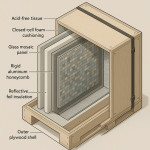Maintenance clauses in mosaic installation contracts that protect both sides
A well-written maintenance clause is the safety net that keeps a stunning mosaic from becoming an expensive liability. Discover the indispensable language, schedules and KPIs that safeguard both the artist and the commissioner long after the last tile is set.
Why maintenance clauses matter for mosaics
Mosaic surfaces live at the intersection of art and architecture. They face weather, cleaning chemicals, foot traffic and public scrutiny. Without crystal-clear maintenance clauses, disputes over fading grout or loose tesserae can erase profits and poison relationships. A concise maintenance clause:
- Defines duties and schedules for preventive care.
- Allocates risk fairly between installer, client and third-party cleaners.
- Sets performance metrics that signal when warranty work kicks in.
- Provides documentation to satisfy insurers and heritage boards.
Core types of maintenance clauses
| Clause type | Artist obligations | Client obligations | Typical duration |
|---|---|---|---|
| Preventive schedule | Deliver care handbook; train facility staff. | Follow handbook; log every cleaning. | 10 – 25 years (site dependent). |
| Warranty trigger | Repair adhesion failure within 30 days. | Report issue with dated photos within 7 days. | Usually 2 – 5 years. |
| Inspection KPI | Attend annual joint inspection. | Provide lift equipment and safe access. | Full life cycle. |
| Cost-sharing formula | Absorb labour on manufacturing defects. | Fund parts and site prep after warranty. | Post-warranty only. |
| Dispute pathway | Supply samples for third-party lab test. | Select accredited mediator within 15 days. | Throughout contract. |
Writing balanced preventive maintenance schedules
1. Reference testable standards
Align cleaning intervals with ASTM C1243 or equivalent regional stone and glass guidelines. This shields the artist from vague expectations while giving the client a benchmark recognised by insurers.
2. Define acceptable patina
Not every stain is a defect. Specify colour variance tolerance (e.g., ΔE 2000 ≤ 3) to prevent unnecessary call-backs.
3. Lock in inspection cadence
Annual inspections are common for exterior mosaic façades; quarterly for high-traffic floors. State who supplies ladders, PPE and traffic diversions.
4. Attach a care handbook as an exhibit
The handbook lists approved detergents, brush materials and maximum pressure for water jets. Tie warranty validity to following these instructions.
Cost-sharing models that keep partnerships friendly
Adhesive failure due to substrate movement is a grey area. Balanced clauses often:
- Split direct costs 50/50 if failure occurs after year 3 but before year 10.
- Place a per-incident ceiling (e.g., 5 % of contract value) to prevent runaway bills.
- Require both parties to file an insurance claim before tapping the cost-sharing pool.
Need an in-depth look at sourcing choices that reduce such failures? Our guide on material sourcing tricks for landmark mosaic walls walks you through substrate compatibility checks.
Negotiation tips for mosaic artists
- Propose inspection bundles – Offer a five-year package at a discounted hourly rate to secure recurring revenue.
- Use mock-up data – Reference adhesion tests from your 3D visual trials (see immersive 3D mock-ups) to justify maintenance intervals.
- Show restoration credentials – Linking to your heritage portfolio (restoration credentials article) reassures clients you can diagnose long-term issues.
Red flags when reviewing maintenance clauses
- Vague wording such as “periodic cleaning” without dates.
- No mention of who funds access equipment for future repairs.
- Warranty that voids if any third-party touches the mosaic, even for unrelated building work.
- Absence of a photo log requirement—difficult to prove negligence later.
Case study: Transit hub floor mosaic
A 400 m² glass mosaic was installed in a European train station. The parties included:
“If more than 2 % of tesserae detach within a quarter, the installer will mobilise a repair team within 14 days, labour at no cost, materials at cost plus 10 % markup.”
Because both sides agreed to keep a public photo archive, the artist quickly demonstrated that a forklift accident—not adhesive failure—caused a later crack, saving €18 000 in repair costs.
Transport hubs often require specialised crating for spare tiles. For crate specs and insurer expectations, check out our guide on safe crating and freight for oversized mosaics.
Maintenance clauses and sustainability
Specifying pH-neutral cleaners and low-VOC sealants aligns with corporate ESG targets and boosts the project's listing on the ArtFolio sustainable craft directory. Embedding these eco criteria in maintenance language helps clients uphold public commitments without renegotiating later.
FAQ
- What exactly is a maintenance clause?
- A maintenance clause defines the actions, timeline and responsibilities for keeping a mosaic installation in optimal condition after handover.
- How long should warranty-related maintenance last?
- Most mosaic warranties run two to five years, but preventive maintenance schedules often extend 10 – 25 years for exterior works.
- Can clients hire a third-party cleaner?
- Yes—if the contract allows it and the cleaner follows the artist's care handbook. Otherwise the warranty may be void.
- What metrics prove a defect?
- Common KPIs include percentage of detached tiles per area, colour shift ΔE values and grout erosion depth in millimetres.
- Who pays for scaffolding during repairs?
- Best practice is to spell out a cost-sharing formula or cap; otherwise local law or building management rules decide.
Quick self-test: Are your clauses watertight?
Takeaway and next steps

Maintenance clauses are not boilerplate; they are the living roadmap that keeps a mosaic vibrant and both parties profitable. Start by auditing your current template, insert measurable KPIs and align cost-sharing caps with project value. Ready to refine your entire contract package? Download our free checklist or book a 30-minute clause audit today.











